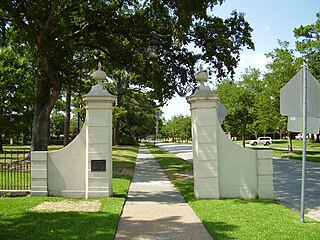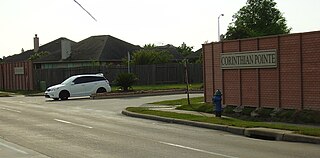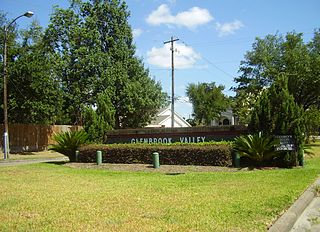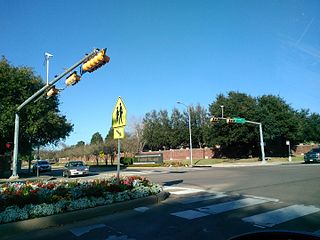
Southside Place is a city in west central Harris County, Texas, United States. The population was 1,715 at the 2010 census.

River Oaks is a residential community located in the center of Houston, Texas, United States. Located within the 610 Loop and between Downtown and Uptown, the community spans 1,100 acres (450 ha). Established in the 1920s by brothers Will Hogg and Michael Hogg, the community became a well-publicized national model for community planning. Real estate values in the community range from $1 million to over $20 million. River Oaks was also named the most expensive neighborhood in Houston in 2013. The community is home to River Oaks Country Club, which includes a golf course designed by architect Donald Ross and redesigned in 2015 by Tom Fazio.

Upper Kirby is a commercial district in Houston, Texas, United States. It is named after Kirby Drive, so indirectly takes its name from John Henry Kirby.

Braeswood Place is a group of subdivisions in Harris County, Texas, United States. The vast majority of the land is in Houston while a small part is in Southside Place.

Southampton Place, also known as Southampton, is a neighborhood located in Houston, Texas. The Southampton Civic Club Inc. is the homeowners' association.

Rice Military is a neighborhood in Houston, Texas, United States. The Beer Can House is located in Rice Military.
Southgate is a neighborhood in Houston, Texas, United States.

Boulevard Oaks is a neighborhood in Houston, Texas, United States, containing 21 subdivisions north of Rice University and south of U.S. Highway 59. Developed primarily during the 1920s and 1930s, Boulevard Oaks contains two National Register historic districts, Broadacres and Boulevard Oaks. The Boulevard Oaks Civic Association (BOCA) is the common civic association for all 21 subdivisions.

Edgar Allan Poe Elementary School is a primary school located at 5100 Hazard Street in Houston, Texas, United States. A part of the Houston Independent School District (HISD), the school, which was built during the 1920s, is located in the Chevy Chase subdivision of the Boulevard Oaks neighborhood west of Rice University. The school, a National Register of Historic Places (NRHP) historic district contributing property of Boulevard Oaks, was named after Edgar Allan Poe.

University Oaks is a subdivision in southeast Houston with approximately 240 homes located adjacent to the University of Houston. It is bounded by Wheeler Avenue to the north, South MacGregor Way to the south, Calhoun Road to the east, and Cullen Boulevard to the west.

Corinthian Pointe is a large planned affordable subdivision located in Houston, Texas, in the United States. It is a part of the larger master planned community Pointe 2.3.4, and is within the 5 Corners District.

Glenbrook Valley is a subdivision located in Houston, Texas, United States.
Crestwood/Glen Cove is a community in Houston, Texas. It consists of the Crestwood and Glen Cove subdivisions. The Crestwood/Glen Cove Civic Club serves the Crestwood/Glen Cove community.
Sunset Terrace and Montclair Place are two Inner Loop neighborhoods of Harris County, Texas, United States. The two subdivisions are served by the Sunset Terrace/Montclair Civic Association.

Joseph Stephen Cullinan was a U.S. oil industrialist. Although he was a native of Pennsylvania, his lifetime business endeavors would help shape the early phase of the oil industry in Texas. He founded The Texas Company, which would eventually be known as Texaco Incorporated.
Morningside Place is a group of subdivisions located in Houston, Texas, United States.

John Fanz Staub was a residential architect who designed numerous traditionally-styled homes and mansions, mostly in Houston, Texas, from the 1920s to 1960s.
West Oaks is a small subdivision in Houston, Texas. It is east of, and in close proximity to, Tanglewood proper. Mimi Swartz of National Geographic wrote that compared to River Oaks, West Oaks is "more nondescript". Beginning in the 1990s, George H. W. Bush became a resident of the neighborhood.

Westwood is a residential subdivision in Southwest Houston, Texas. The subdivision is bounded by the 610 Loop, the Union Pacific railroad tracks, Stella Link Road, and Willowbend Boulevard. It has about 800 houses.

Parkway Villages is a 577-lot, 224-acre (91 ha) subdivision in western Houston, Texas. It is located north of Lakes of Parkway, the former Barnhardt land tract. It was the first single family housing development by Sueba USA, a subsidiary of Süba Freie Baugesellschaft.

















